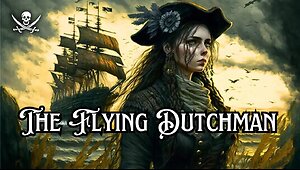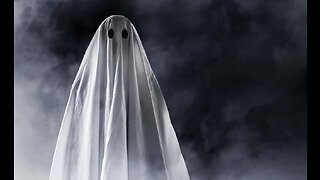Mystery of the Flying Dutchman Ghost Ship Phenomenon - Full Documentary
The Flying Dutchman (Dutch: De Vliegende Hollander) is a legendary ghost ship which was said to never be able to make port, doomed to sail the oceans forever. The myth is likely to have originated from the 17th-century Golden Age of the Dutch East India Company (VOC) and Dutch maritime power. The oldest extant version of the legend has been dated to the late 18th century. According to the legend, if hailed by another ship, the crew of the Flying Dutchman was said to try to send messages to land, or to people long dead. Purported sightings in the 19th and 20th centuries claimed that the ship glowed with a ghostly light. In ocean lore, the sight of this phantom ship is a portent of doom. Sightings of these ship in the middle of the sea ( which was just an optical illusion ) used to shake the sailors to the core. The first print reference to the ship appears in Travels in various part of Europe, Asia and Africa during a series of thirty years and upward (1790) by John MacDonald: "The weather was so stormy that the sailors said they saw the Flying Dutchman. The common story is that this Dutchman came to the Cape in distress of weather and wanted to get into harbor but could not get a pilot to conduct her and was lost and that ever since in very bad weather her vision appears." The next literary reference appears in Chapter VI of A Voyage to Botany Bay (1795) (also known as A Voyage to New South Wales), attributed to George Barrington (1755–1804): "I had often heard of the superstition of sailors respecting apparitions and doom, but had never given much credit to the report; it seems that some years since a Dutch man-of-war was lost off the Cape of Good Hope, and every soul on board perished; her consort weathered the gale, and arrived soon after at the Cape. Having refitted, and returning to Europe, they were assailed by a violent tempest nearly in the same latitude. In the night watch some of the people saw, or imagined they saw, a vessel standing for them under a press of sail, as though she would run them down: one in particular affirmed it was the ship that had foundered in the former gale, and that it must certainly be her, or the apparition of her; but on its clearing up, the object, a dark thick cloud, disappeared. Nothing could do away the idea of this phenomenon on the minds of the sailors; and, on their relating the circumstances when they arrived in port, the story spread like wild-fire, and the supposed phantom was called the Flying Dutchman. From the Dutch the English seamen got the infatuation, and there are very few Indiamen, but what has some one on board, who pretends to have seen the apparition." The next literary reference introduces the motif of punishment for a crime, in Scenes of Infancy (Edinburgh, 1803) by John Leyden (1775–1811): "It is a common superstition of mariners, that, in the high southern latitudes on the coast of Africa, hurricanes are frequently ushered in by the appearance of a spectre-ship, denominated the Flying Dutchman ... The crew of this vessel are supposed to have been guilty of some dreadful crime, in the infancy of navigation; and to have been stricken with pestilence ... and are ordained still to traverse the ocean on which they perished, till the period of their penance expire." Thomas Moore (1779–1852) places the vessel in the north Atlantic in his poem Written on passing Dead-man's Island in the Gulf of St. Lawrence, Late in the evening, September, 1804:[13] "Fast gliding along, a gloomy bark / Her sails are full, though the wind is still, / And there blows not a breath her sails to fill." A footnote adds: "The above lines were suggested by a superstition very common among sailors, who call this ghost-ship, I think, 'the flying Dutch-man'." Sir Walter Scott (1771–1832), a friend of John Leyden's, was the first to refer to the vessel as a pirate ship, writing in the notes to Rokeby; a poem (first published December 1812) that the ship was "originally a vessel loaded with great wealth, on board of which some horrid act of murder and piracy had been committed" and that the apparition of the ship "is considered by the mariners as the worst of all possible omens". #legend #myth #supernatural
-
 4:31
4:31
History of Pirates
7 months ago $0.01 earnedThe Ghost Ship Tale of the Flying Dutchman | History of Pirates
961 -
 42:22
42:22
EIAcademy
4 months agoThe Spooky Crew Ghost Stories
10 -
 58:35
58:35
Disclosed: UFO Files
5 months agoIncredible UFO Encounters - FULL PARANORMAL DOCUMENTARY
145 -
 10:07
10:07
Fascinating Horror
9 months agoThe Mystery of Flight 823 | Fascinating Horror
1.06K -
 0:54
0:54
David Newcomb
1 year agoGhost Ship (2012)
3 -
 52:16
52:16
didi1878
2 years agoThe Dark Pictures Anthology Man of Medan Part 3 : Ghost Ship
34 -
 2:12
2:12
Lions Ground
10 months agoMysterious TRIANGULAR UFO Spotted in the Netherlands: Stranger than Fiction? 🔺
27 -
 2:29
2:29
TheLiarzTable
1 year agoGhost Ship Mary Celeste: The 150 Year Old Mystery
84 -
 2:15:55
2:15:55
All Things Art Bell
1 year agoCoast to Coast - Ghost Stories 04/13/1996
8292 -
 4:13:15
4:13:15
Paranormal Channel
1 year agoThe collection of 30 Unexplained Mysteries Documentaries
207